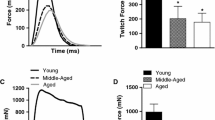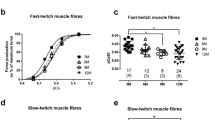Abstract
The myosin heavy chain (MyHC) content in functionally different parts of the human masseter muscle of six elderly and five young adult subjects (mean age 74 and 22 years, respectively) was determined, using gel electrophoresis. The MyHC composition of the old masseter was also studied by enzyme- and immunohistochemical methods and compared with previous data for young adults. For comparison, the biceps brachii muscle of the same subjects was also analysed. The old masseter contained smaller amounts of slow and larger amounts of fast and fetal MyHCs. These differences were region-dependent and were more pronounced in the superficial portion. There was also a larger proportion of “hybrid” fibres, containing two to four MyHC isoforms (42%), compared with the young adult masseter (23%). No such differences were observed between old and young biceps. In contrast to the masseter, the old biceps contained more slow MyHC and less fast MyHC. This investigation demonstrates that the aging process in human skeletal muscle is accompanied by a modification in the muscle phenotype which is both muscle and region specific; a transformation towards a fast and fetal phenotype concomitant with an increased number of fibres with a mixture of different MyHC isoforms in the masseter; and an opposite shift towards a slower phenotype in the biceps brachii. The results might reflect differences between jaw and limb muscles in genetic programs and adaptive responses to changed functional demands following aging.
Similar content being viewed by others
References
Altman DG (1991) Practical statistics for medical research. 1st edn. Chapman and Hall, London (pp. 194-197, 334-336).
Barbet JP, Thornell L-E and Butler-Browne GS (1991) Immunocy-tochemical characterisation of two generations of fibers during the development of the human quadriceps muscle. Mech Dev 35: 3-11.
Bär A and Pette D (1988) Three fast myosin heavy chains in adult rat skeletal muscle. FEBS Lett 235: 153-155.
Bredman JJ, Wessels A, Weijs WA, Korfage JA, Soffers, CA and Moorman AF (1991) Demonstration of `cardiac-specific' myosin heavy chain in masticatory muscles of human and rabbit. Histochem J 23: 160-170.
Brooke MH and Kaiser, KK (1970) Muscle fiber types: how many and what kind? Arch Neurol 23: 369-379.
Butler-Browne GS, Eriksson P-O, Laurent C and Thornell L-E (1988) Adult human masseter muscle fibers express myosin isozymes characteristic of development. Muscle Nerve 11: 610-620.
Butler-Browne GS, Barbet JP and Thornell L-E (1990) Myosin heavy and light chain expression during human skeletal muscle development and precocious muscle maturation induced by thyroid hormone. Anat Embryol 181: 513-522.
Carraro U and Catani C (1983) A sensitive SDS-PAGE method separating myosin heavy isoforms of rat skeletal muscles reveals the heterogeneous nature of the embryonic myosin. Biochem Biophys Res Commun 116: 793-802.
Dubowitz V (1985) Muscle biopsy-A practical approach. 2nd edn. (pp. 34-102) Bailliére Tindall, London.
Edom F, Mouly V, Barbet JP, Fiszman MY and Butler-Browne GS (1994) Clones of human satellite cells can express in vitro both fast and slow myosin heavy chains. Dev Biol 164: 219-229.
Engel WK and Cunningham GG (1963) Rapid examination of muscle tissue. An improved trichrome method for fresh-frozen biopsy sections. Neurology 13: 919-923.
Ennion S, Sant'ana Pereira J, Sargeant AJ, Young A and GOLDS-PINK G (1995) Characterization of human skeletal muscle fibres according to the myosin heavy chains they express. J Muscle Res Cell Motil 16: 35-43.
Eriksson P-O, Eriksson A, Ringqvist M, and Thornell L-E (1980) The reliability of histochemical fibre typing of human necropsy muscles. Histochemistry 65: 193-205.
Eriksson P-O, (1982) Muscle-fibre composition of the human mandibular locomotor system. Enzyme-histochemical and morphological characteristics of functionally different parts. Swed Dent J 12: 1-44.
Eriksson P-O and Thornell L-E (1983) Histochemical and morphological muscle-fibre characteristics of the human masseter, the medial pterygoid and the temporal muscles. Archs Oral Biol 28: 781-795.
Eriksson P-O, Butler-Browne GS and Thornell L-E (1994) Immuno-histochemical characterization of human masseter muscle spindles. Muscle Nerve 17: 31-41.
Gambke B and Rubinstein NA (1984) A monoclonal antibody to the embryonic myosin heavy chain of rat skeletal muscle. J Biol Chem 259: 12092-12100.
Harridge SD, White MJ, Carrington CA, Goodman M and Cummins P (1995) Electrically evoked torque-velocity characteristics and isomyosin composition of the triceps surae in young and elderly men. Acta Physiol Scand 154: 469-477.
Havenith MG, Visser R, Schrijvers-Van-Schendel JM and Bosman FT (1990) Muscle fiber typing in routinely processed skeletal muscle with monoclonal antibodies. Histochemistry 93: 497-499.
Hughes SM, Cho M, Karsch-Mizrachi I, Travis M, Silberstein L, Leinwand LA and Blau HM (1993) Three slow myosin heavy chains sequentially expressed in developing mammalian skeletal muscle. Dev Biol 158: 183-199.
Hoh JFY, Hughes S, Hugh G and Pozgaj I (1989) Three hierarchies in skeletal muscle fibre classification allotype, isotype, and pheno-type. In: Stockdale F and Kedes L (eds.) UCLA Symposia on Molecular and Cellular Biology. Vol. 93, (pp. 15-26). Alan R Liss Inc, New York.
Kossioni AE and Karkazis, HC (1994) EMG study on the effect of ageing on the human masseteric jaw-jerk reflex. Gerodontology 11: 30-38.
Klitgaard H, Mantoni M, Schiaffino S, Ausoni S, Gorza L, Laurent-Winter C. Schnohr P and Saltin B (1990) Function, morphology and protein expression of ageing skeletal muscle: a cross-sectional study of elderly men with different training backgrounds. Acta Physiol Scand 240: 41-54.
Larsson L, Li X and Frontera WR (1997) Effects of aging on shortening velocity and myosin isoform composition in single human skeletal muscle cells. Am J Physiol 272: C638-C649.
Leger JO, Bouvagnet P, Pau B, Roncucci R and Leger JJ (1985) Levels of ventricular myosin fragments in human sera after myocardial infarction, determined with monoclonal antibodies to myosin heavy chains. Eur J Clin Invest 15: 422-429.
Manson JD and Lucas RB (1962) A microradiographic study of age changes in the human mandible. Arch Oral Biol 7: 761-769.
Monemi M, Eriksson P-O, Dubail I, Butler-Browne GS and Thornell L-E (1996) Fetal myosin heavy chain increases in the human masseter muscle during aging. FEBS Lett 386: 87-90.
Monemi M, Eriksson P-O, Eriksson A and Thornell L-E (1998) Adverse changes in fibre type composition of the human masseter versus biceps brachii muscle during aging. J Neurol Sci 154: 35-48.
Newton JP and Yemm R (1990) Age changes in contractile properties of masseter muscle in man. J Oral Rehab 17: 204-205.
Pedrosa-Domellöf, F, Eriksson P-O, Butler-Browne GS and Thornell L-E (1992) Expression of alpha-cardiac myosin heavy chain in mammalian skeletal muscle. Experientia 48: 491-494.
Pette D and Staron RS (1997) Mammalian skeletal muscle fiber type transitions. Int Rev Cytol 170: 143-223.
Porter MM, Vandervoort AA, and Lexell J (1995) Aging of human muscle: structure, function and adaptability. Scand J Med Sci Sports 5: 129-142.
Ringqvist M (1974) Fiber types in human masticatory muscles. Relation to function. Scand J Dent Res 82: 333-355.
Sant'ana Pereira JA, Ennion S, Sargeant AJ, Moorman AF. and Goldspink G (1997) Comparison of the molecular, antigenic and ATPase determinants of fast myosin heavy chains in rat and human: a single-fibre study. Pflugers Arch 435: 151-63.
Schiaffino S, Saggin L, Viel A, Ausoni S, Sartore S, and Gorza L (1986) Muscle fiber types identified by monoclonal antibodies to myosin heavy chains. In: Benzi G, Packer L and Siliprandi N (eds.) Biochemical Aspects of Physical Exercise. (pp. 27-34). Elsevier, Amsterdam.
Schiaffino S, Gorza L, Sartore S, Saggin L, Ausoni S, Vianello M, Gundersen K and Lomo T (1989) Three myosin heavy chain isoforms in type 2 skeletal muscle fibres. J Muscle Res Cell Motil 10: 197-205.
Sciote JJ, Rowlerson AM, Hopper C and Hunt NP (1994) Fibre type classification and myosin isoforms in the human masseter muscle. J Neurol Sci 126: 15-24.
Smerdu V, Karsch-Mizrachi I, Campione M, Leinwand L and Schiaffino S (1994) Type IIx myosin heavy chain transcripts are expressed in type IIb fibers of human skeletal muscle. Am J Physiol 267: C1723-C1728.
Smith A, Weber CM, Newton J and Denny M (1991) Developmental and age-related changes in reflexes of the human jaw-closing system. Electroencephalogr Clin Neurophysiol 81: 118-128.
Soussi-Yanicostas N, Barbet JP, Laurent-Winter C, Barton P and Butler-Browne GS (1990) Transition of myosin isozymes during development of human masseter muscle. Persistence of develop-mental isoforms during postnatal stage. Development 108: 239-249.
Staron RS (1991) Correlation between myofibrillar ATPase activity and myosin heavy chain composition in single human muscle fibres. Histochemistry 96: 21-24.
Sternberger LA (1979) Immunohistochemistry. 2nd edn. Wiley Medical, New York.
Stål P, Eriksson P-O, Schiaffino S, Butler-Browne GS and Thornell L-E (1994) Differences in myosin composition between human oro-facial, masticatory and limb muscles: enzyme-, immunohisto-and biochemical studies. J Muscle Res Cell Motil 15: 517-534.
Tajbakhsh S, Rocancourt D, Cossu G and Buckingham M (1997) Redefining the genetic hierarchies controlling skeletal myogenesis: Pax-3 and Myf-5 act upstream of MyoD. Cell 89: 127-138.
Thornell L-E, Billeter R, Eriksson P-O and Ringqvist M (1984) Heterogeneous distribution of myosin in human masticatory muscle fibres as shown by immunocytochemistry. Arch Oral Biol 29: 1-5.
Whalen RG, Sell SM, Butler-Browne GS, Schwartz K, Bouveret P, and Pinset-Härström I (1981) Three myosin heavy-chain isozymes appear sequentially in rat muscle development. Nature 292: 805-809.
Author information
Authors and Affiliations
Rights and permissions
About this article
Cite this article
Monemi, M., Eriksson, PO., Kadi, F. et al. Opposite changes in myosin heavy chain composition of human masseter and biceps brachii muscles during aging. J Muscle Res Cell Motil 20, 351–361 (1999). https://doi.org/10.1023/A:1005421604314
Issue Date:
DOI: https://doi.org/10.1023/A:1005421604314




